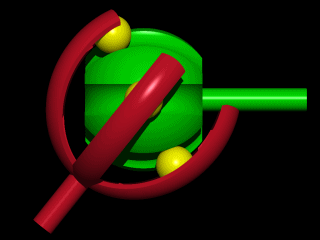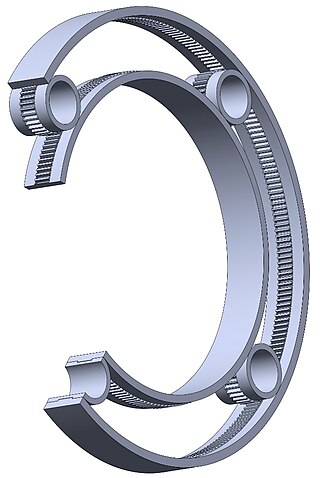
AB SKF is a Swedish bearing and seal manufacturing company founded in Gothenburg, Sweden, in 1907. The company manufactures and supplies bearings, seals, lubrication and lubrication systems, maintenance products, mechatronics products, power transmission products, condition monitoring systems and related services globally.

An axle or axletree is a central shaft for a rotating wheel or gear. On wheeled vehicles, the axle may be fixed to the wheels, rotating with them, or fixed to the vehicle, with the wheels rotating around the axle. In the former case, bearings or bushings are provided at the mounting points where the axle is supported. In the latter case, a bearing or bushing sits inside a central hole in the wheel to allow the wheel or gear to rotate around the axle. Sometimes, especially on bicycles, the latter type of axle is referred to as a spindle.

A ball bearing is a type of rolling-element bearing that uses balls to maintain the separation between the bearing races.

A bearing is a machine element that constrains relative motion to only the desired motion and reduces friction between moving parts. The design of the bearing may, for example, provide for free linear movement of the moving part or for free rotation around a fixed axis; or, it may prevent a motion by controlling the vectors of normal forces that bear on the moving parts. Most bearings facilitate the desired motion by minimizing friction. Bearings are classified broadly according to the type of operation, the motions allowed, or the directions of the loads (forces) applied to the parts.

In mechanical engineering, a rolling-element bearing, also known as a rolling bearing, is a bearing which carries a load by placing rolling elements between two concentric, grooved rings called races. The relative motion of the races causes the rolling elements to roll with very little rolling resistance and with little sliding.

A caster is an undriven wheel that is designed to be attached to the bottom of a larger object to enable that object to be moved.

A constant-velocity joint is a mechanical coupling which allows the shafts to rotate freely as the angle between the two shafts moves within a certain range.

A thrust bearing is a particular type of rotary bearing. Like other bearings they permanently rotate between parts, but they are designed to support a predominantly axial load.

Rolling is a type of motion that combines rotation and translation of that object with respect to a surface, such that, if ideal conditions exist, the two are in contact with each other without sliding.

A pillow block bearing is a pedestal used to provide support for a rotating shaft with the help of compatible bearings and various accessories. The assembly consists of a mounting block which houses a bearing. The block is mounted to a foundation and a shaft is inserted allowing the inner part of the bearing / shaft to rotate. The inside of the bearing is typically 0.025 millimetres (0.001 in) larger diameter than the shaft to ensure a tight fit. Set screws, locking collars, or set collars are commonly used to secure the shaft. Housing material for a pillow block is typically made of cast iron or cast steel.

Tapered roller bearings are rolling element bearings that can support axial forces as well as radial forces.
A linear-motion bearing or linear slide is a bearing designed to provide free motion in one direction. There are many different types of linear motion bearings.

In an automobile, ball joints are spherical bearings that connect the control arms to the steering knuckles, and are used on virtually every automobile made. They bionically resemble the ball-and-socket joints found in most tetrapod animals.

A wire race bearing is a rolling-element bearing, where the balls or rollers run on races resembling loops of wire. Roller bearings may use just two races, but ball bearings typically use three or four races. Wire race bearings can be large yet lightweight and with small profile and good precision. Wire races have little intrinsic structure and must be adequately supported by the bearing housing. Balls, rollers or even cross rollers are used as rolling elements. Due to the design wire race bearings are commonly called '4-point-contact' bearings.

To "slew" means to turn without change of place.

NTN Corporation is one of the most prominent manufacturers of bearings in Japan, second domestically only to NSK Ltd. The company is one of the largest exporters worldwide of friction-reducing products such as constant-velocity joints.

A spherical roller bearing is a rolling-element bearing that permits rotation with low friction, and permits angular misalignment. Typically these bearings support a rotating shaft in the bore of the inner ring that may be misaligned in respect to the outer ring. The misalignment is possible due to the spherical internal shape of the outer ring and spherical rollers. Despite what their name may imply, spherical roller bearings are not truly spherical in shape. The rolling elements of spherical roller bearings are mainly cylindrical in shape, but have a profile that makes them appear like cylinders that have been slightly over-inflated.

A spherical roller thrust bearing is a rolling-element bearing of thrust type that permits rotation with low friction, and permits angular misalignment. The bearing is designed to take radial loads, and heavy axial loads in one direction. Typically these bearings support a rotating shaft in the bore of the shaft washer that may be misaligned in respect to the housing washer. The misalignment is possible due to the spherical internal shape of the house washer.

A gear bearing is a type of rolling-element bearing similar to an epicyclic gear. Gear bearings consist of a number of smaller 'satellite' gears which revolve around the center of the bearing along a track on the outsides of the internal and satellite gears, and on the inside of the external gear. Each gear is in between two concentric rings. Therefore, the widths of the satellite gears must all be the same.
A cannon bearing or cannon box bearing is an arrangement of bearings on a shaft, usually an axle, where two bearings are mounted in an enclosed tube.



















